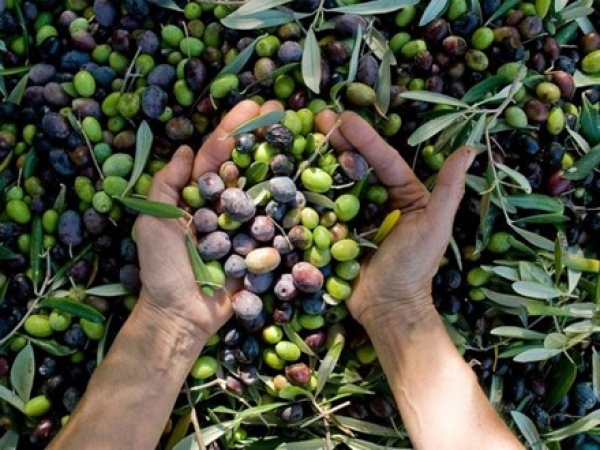And every year, from April to November, I am very lucky to have the chance to “make” something, to create it from scratch, to see it being born and rise from the earth, until the time when it becomes really a part of the family. I am talking about the family’s olive grove on Lake Garda and its wonderful, most precious offspring: extra virgin olive oil. My father bought an olive grove in Puegnago, on Lake Garda, almost 40 years ago, and since then every year in November we have been celebrating a feast that is also a coming back to the earth, to my father’s mountain origins, a celebration of work by hands. And this year, everything notwithstanding, nature gave us its precious fruits once again, and we turned them into our most precious good, our olive oil.
Processing olives is an art: from harvesting to milling, up to tasting their flavour in our dishes. The secrets of good olive oil have always been the same everywhere: healthy olive trees on fertile soils, immediate crushing and clean and state-of-the-art mills. But in Italy we also have an advantage, as we have 538 varieties of olives, the largest number in the world. Olive oil looks like a very simple product: you pick the olives, you squeeze them, et voila. But behind these simple operations, there is a world of nuances which make the difference between an excellent oil and a medium quality one. So let’s start from the beginning. Today I want to talk to you about the first stage of the production of extra virgin olive oil: the harvesting of olives. In the following article I will tell you the secrets of olive oil and how to recognize an excellent Italian olive oil. First of all, what does Extra Virgin Olive Oil mean?
First of all, what does Extra Virgin Olive Oil mean?
You have many types of oils, from sunflowers, peanuts, various seeds, but olive oil, and in particular extra virgin (or EVO) is undoubtedly the best. To be called extra virgin olive oil, it must be obtained by extraction with mechanical methods only and have an “acidity degree” of less than 0.8%: this makes it the only oil produced entirely and only from olives, and its title derives precisely from the fact that nothing else is added (we will see about acidity in the following article). If the oil has an acidity of up to 2%, it is called "only" virgin. To obtain a good EVO oil, olives should be harvested just before full ripening, which in Italy usually is from mid-October to the end of December.
How many Italian olive varieties are there? When it comes to extra virgin olive oil we often hear about "cultivars", what does that mean?
“Cultivar” is an English acronym for "cultivated variety", indicating the varieties of the olive trees. The many varieties in each territory differ in their vegetative characteristics and in production and agronomic aspects. Cultivars are important because the characteristics of the olives can vary, in particular the size, the relationship between pulp and hazelnut and the ripening. Not only that: the concentrations of polyphenols and other components that define the final characteristics of the oil also change. Cultivars are differentiated by fruit size, colour, ripening period, flowering period, flavour, the robustness of the plant, the colour of the leaves.
Italian Cultivars differ also from region to region: factors such as soil composition, altitude or proximity to the sea affect the productivity of the plant and the characteristics of the oil. Thus, Apulian oil will surely differ from a Garda oil, both releasing the flavours of the lands from which they derive. Each region has its own most representative Cultivars, but some of them are cultivated throughout Italy: the cultivar “Leccino”, for example, is present from Lake Garda (my area) to Puglia. Also, each Cultivar should have specific characteristics (flavour, smell, etc...), meaning specific organoleptic characteristics, but depending on how it is grown and the production area it expresses itself differently. For example, in Puglia, from Gargano to Salento, we have a series of cultivars that express a very different territory. The cultivar most present on the Apulian territory, called “Ogliarola”, has different characteristics depending on the area, having as a common thread only a medium-light fruity taste, with a faint aftertaste of bitter and spicy.
Each region has its own most representative Cultivars, but some of them are cultivated throughout Italy: the cultivar “Leccino”, for example, is present from Lake Garda (my area) to Puglia. Also, each Cultivar should have specific characteristics (flavour, smell, etc...), meaning specific organoleptic characteristics, but depending on how it is grown and the production area it expresses itself differently. For example, in Puglia, from Gargano to Salento, we have a series of cultivars that express a very different territory. The cultivar most present on the Apulian territory, called “Ogliarola”, has different characteristics depending on the area, having as a common thread only a medium-light fruity taste, with a faint aftertaste of bitter and spicy.
In Italy, we have more than 500 different cultivars: a unique biodiversity heritage in the world. In Puglia alone, there are 60 million plants, practically one plant for every Italian citizen! It is the most olive-growing region in Italy. An incredible heritage, think that many of these plants can be more than 800 years old, they were planted way before the discovery of America! This means having a very relevant historical, cultural, landscape and tourist heritage.
From each Cultivar, oils that differ in intensity and taste are extracted. Here are some Italian varieties:
1. Garda Lake, cultivar Casaliva
2. Liguria, cultivar Taggiasca
3. Toscana, cultivar Moraiolo
4. Umbria, cultivar Frantoio, Leccino
5. Puglia, cultivar Coratina, Peranzana, Ogliarola
6. Sicilia, cultivar Tonda Iblea, Cerasuola, Nocellara
When do you harvest olives?
The right time is typically from October to the end of December. The factors that determine the "right time" for harvesting are manifold: the type of olive (early or late), the quality of the oil you want to obtain from it and, above all, the climate conditions. The timing and method of collection affect both the quality of the squeezing and the amount of oil produced. The best time for harvesting is when olives start changing their colours, from green to first purple and then black. At this moment there is the greatest quantitative concentration of oil and phenolic substances that bring organoleptic and nutritional qualities to the oil.
 The characteristics of the oil (quality, flavour, acidity level, etc.) change not only depending on the harvesting time but also on the procedure. There are two main modes: manual and mechanical. Olives can be harvested by hand directly from the branches. It’s ideal for low plants and has the great advantage of not damaging olives; it is indicated to produce the highest quality oils as all fruits are selected individually by hand. In this meticulous technique, scales of various types and heights, rakes and combs are used, to check the status of each olive without stressing the branches of the tree. It is a method that involves a lot of work, and above all it is not suitable for tall trees. In this case, you “comb” the branches of the olive tree over and over again with a motorized tool (similar to a rake) that takes olives off. These are collected from nets attached directly under the trees as if they were upside-down umbrellas, and then carefully selected and separated from foliage and pieces of branches. The most common mechanical method uses machines that, thanks to mechanical arms, wrap the trunk or the branches of the tree and move them in a soft and contained way to favour the fall of the fruits. The quality of the product is not significantly affected as these tools are equipped with structures similar to inverted umbrellas where olives fall.
The characteristics of the oil (quality, flavour, acidity level, etc.) change not only depending on the harvesting time but also on the procedure. There are two main modes: manual and mechanical. Olives can be harvested by hand directly from the branches. It’s ideal for low plants and has the great advantage of not damaging olives; it is indicated to produce the highest quality oils as all fruits are selected individually by hand. In this meticulous technique, scales of various types and heights, rakes and combs are used, to check the status of each olive without stressing the branches of the tree. It is a method that involves a lot of work, and above all it is not suitable for tall trees. In this case, you “comb” the branches of the olive tree over and over again with a motorized tool (similar to a rake) that takes olives off. These are collected from nets attached directly under the trees as if they were upside-down umbrellas, and then carefully selected and separated from foliage and pieces of branches. The most common mechanical method uses machines that, thanks to mechanical arms, wrap the trunk or the branches of the tree and move them in a soft and contained way to favour the fall of the fruits. The quality of the product is not significantly affected as these tools are equipped with structures similar to inverted umbrellas where olives fall.
So, now that you know a little more, back to my olives. Hard to believe, the cultivation of olive trees on Lake Garda is the most northerly one in the world! The favourable exposure of the moraine hills and the beneficial influence of Lake Garda allow the olive plants not to suffer excessive summer heat or winter frosts and, at harvest time, the cool autumn temperatures preserve healthy and undamaged fruits.
The main cultivar is the Casaliva, a native variety of Lake Garda. I have been following their ripening since May when you can see the flowers blooming. The season looked good this year, but olives are always at risk: a frost, or an assault of the so-called “olive mosquito”, can compromise the harvest. Last year, due to a late frost, we could not make any oil at all.
Beginning from the first weekend of November, we harvested olives from some 50 trees and we are still harvesting, the season this year is very good. As you can see, we “comb” the trees with a pole machine (we used to do it by hand when we started, 40 years ago). Every time I marvel at the olive tree: not only its shape is always different from one tree to another, it is a triumph of diversification, but also the tree is both strong and very elastic so that you can easily comb it without breaking its branches. I love the olive tree, to me it symbolizes nature at work, slowly but steady, flexible but strong. A prodigy!
 Finally, after cleaning the olives from leave and branches, we pack them and bring them to the olive mill 500 meters from home, where they press them within 24 hours, to avoid fermentation. But here starts another story, which I will tell you next time.
Finally, after cleaning the olives from leave and branches, we pack them and bring them to the olive mill 500 meters from home, where they press them within 24 hours, to avoid fermentation. But here starts another story, which I will tell you next time.
Well, bookings are open for the next season, who wants to come and harvest the olive at Marcello’s house next year?
I’ll see you there. Ciao.


